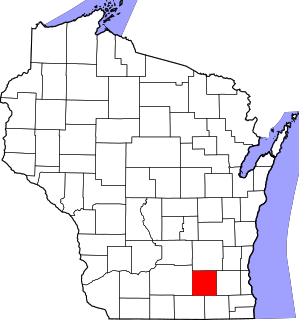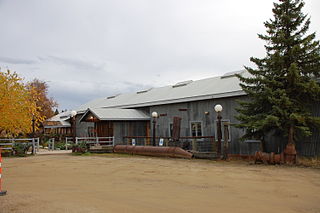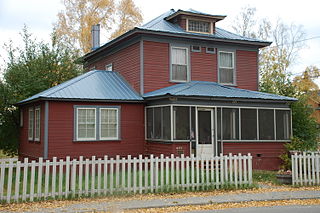
This is a list of the National Register of Historic Places listings in Dane County, Wisconsin. It aims to provide a comprehensive listing of buildings, sites, structures, districts, and objects in Dane County, Wisconsin listed on the National Register of Historic Places.

The F.E. Company Dredge No. 4, also known as the Pedro Dredge and the Chicken Dredge, was originally owned by the Fairbanks Exploration Company, a subsidiary of the United States Smelting Refining & Mining Co. (USSR&M). It was built by the Yuba Manufacturing Company in California, and was shipped to Pedro Creek north of Fairbanks, Alaska in 1938. It was assembled there, and operated until 1958.

This is a list of the National Register of Historic Places listings in Jefferson County, Wisconsin. It is intended to provide a comprehensive listing of entries in the National Register of Historic Places that are located in Jefferson County, Wisconsin. The locations of National Register properties for which the latitude and longitude coordinates are included below may be seen in a map.

This is a list of the National Register of Historic Places listings in Racine County, Wisconsin. It is intended to provide a comprehensive listing of entries in the National Register of Historic Places that are located in Racine County, Wisconsin. The locations of National Register properties for which the latitude and longitude coordinates are included below may be seen in a map.

This is a list of the National Register of Historic Places listings in Fairbanks North Star Borough, Alaska.

The Immaculate Conception Church is a historic church and former cathedral at 115 N. Cushman Street in Fairbanks, Alaska, United States.

The Chicken Historic District encompasses part of the historic mining district of Chicken, Alaska. It is located at milepost 66.5 on the north side of the Taylor Highway, and includes fifteen buildings built between 1908 and 1967. Most of these are single-story wood-frame structures, with either metal or board-and-batten siding, although there are also some log structures. Many of these buildings were erected by the Fairbanks Exploration Company, which ran the gold mining operations in the area. Notable buildings include the bunkhouse, a gabled log structure, and the Chicken Creek Roadhouse, built in 1906, which was originally two stories in height but was reduced to a single story in 1924. The district also includes a section of water pipeline built by the company to bring water to the area from Mosquito Creek, a distance of about 1 mile (1.6 km). The camp was used until the company ended mining operations in 1967.

The Chatanika Gold Camp is a historic gold mining camp at Mile 27¾ of the Steese Highway in Chatanika, Alaska. The camp is set on about 49 acres (20 ha) overlooking Cleary Creek, and consists of thirteen buildings as well as a scattering of old mining tools and equipment. The largest of the buildings are two bunkhouses, finished in corrugated metal. The camp was built in 1925 by the Fairbanks Exploration Company (FEC), which also dug the nearby Davidson Ditch to supply water for the operation of the gold dredges. The Chatanika Camp was the largest of the FEC's mining camps in the Fairbanks area. Five of the surviving buildings date to the initial construction period.

The Chena Pump House, also known just as the Pump House Restaurant, is a restaurant at 796 Chena Pump Road in Fairbanks, Alaska. The restaurant is located in the shell of a 1933 pumping station established by the Fairbanks Exploration Company, Alaska's largest gold mining operator at the time. The pump house was used to provide water to dredges operating on Cripple Creek in the Ester area. The building was abandoned by the company in 1958, and was enlarged and converted into a restaurant in 1978. It was listed on the National Register of Historic Places in 1982.

The Mary Lee Davis House is a historic house at 410 Cowles Street in Fairbanks, Alaska. It is now the Alaska Heritage House, a bed and breakfast inn. It is a 1+1⁄2-story bungalow-style house, set at the northern corner of Cowles and 5th Avenue in a residential area of the city. The exact construction date of the house is uncertain: it was probably complete by 1916, but construction may have begun as early as 1906; it is acknowledged as the city's oldest occupied residence. The unfinished house was purchased by writer Mary Lee Davis and her husband, who finished the building and added a number of its distinctive touches, including the city's first residential coal heating system. After a period of ownership by the Fairbanks Exploration Company, during which it was home to company executives, it went through a succession of owners before being converted to a bed and breakfast.

The Fairbanks Exploration Company was the major economic force in the growth of Fairbanks, Alaska during its gold rush years in the early 20th century. In the 1920s the company built a number of housing units for its workers. A cluster of at least eight of these is known to have survived on the east side of Illinois Street, of which four have retained historical integrity. Located at 505, 507, 521, and 523 Illinois Street, they are all similarly built Bungalow-style wood-frame buildings, 1+1⁄2 stories in height, with a hip roof and projecting hipped wings. The complex includes a five-stall garage which served all four houses, as well as two greenhouses. At the time of their listing on the National Register of Historic Places in 1997, this group of houses was being rehabilitated for use as a bed and breakfast inn.

The Fairbanks Exploration Company Manager's House, also known as The White House and the Sisters' Convent, is a historic house at 757 Illinois Street in Fairbanks, Alaska. It is a three-story wood-frame structure, five bays wide, with a side gable roof, clapboard siding, and a post-and-beam foundation. An ell extends from the center of the rear. The house was built in 1935-36 by the Fairbanks Exploration Company to house its local vice president and general manager. It is the first Colonial Revival house built in Fairbanks, and is one of the state's finest examples of the style.

The Fairbanks Exploration Company Dredge No. 2 is a historic gold mining dredge in a remote area of Fairbanks North Star Borough, Alaska, northeast of the city of Fairbanks. It is currently located on the north bank of Fish Creek, shortly northeast of the mouth of Slippery Creek. Its main structure is a compartmented steel hull, 128 feet (39 m) long, 60 feet (18 m) wide, and 12 feet (3.7 m) high, with a 1-2 story superstructure above made of steel and wood framing sheathed in corrugated metal. It has three gantries, and a digging ladder 112 feet (34 m) long at its bow that weights 178,000 pounds (81,000 kg). All of its original operating equipment was reported to be in place in 1999. The dredge was built in 1927 by the Bethlehem Steel Company, and assembled for use in Alaska in 1928. It was operated by the Fairbanks Exploration Company in the Goldstream Valley from 1928 to 1949, and on Fairbanks Creek and lower Fish Creek from 1950 to 1961.

The Fairbanks Exploration Company Gold Dredge No. 5 was a historic gold mining dredge in a remote area of Fairbanks North Star Borough, Alaska, north of the city of Fairbanks. It was last located on Upper Dome Creek, shortly northeast of the mouth of Seattle Creek, about 20 miles (32 km) north of Fairbanks, prior to its being scrapped c. 2012. The dredge was manufactured by the Bethlehem Steel Company in 1928, shipped in pieces to Alaska, and assembled by the Fairbanks Exploration Company on Cleary Creek, where it was used until 1942. It thereafter served on Eldorado Creek (1947–55) and Dome Creek (1955-59) before it was abandoned.

The Old Federal Building is a historic government building at Cushman Street and 3rd Avenue in Fairbanks, Alaska. When it was built in 1933, it was the most northern instance of concrete construction in the United States. It is a large building with three full-height floors and two smaller penthouse levels. The building's Art Deco styling includes V-shaped grooves set in pilasters that separate columns of windows and aluminum panels. The grooves are repeated in concrete spandrels above the top row of windows. Interior decoration includes terrazzo flooring, copious use of marble in walls and floors, and a pressed copper ceiling in the courtroom. The building was designed by Washington, DC architect George N. Ray, and built by William "Mac" MacDonald, who also later built the Federal Building in Nome. It originally housed the federal court, post office, and other federal government offices, and the decision to locate it in Fairbanks was critical to the rise of the city's importance; it now houses private offices.

The Illinois Street Historic District encompasses the principal business and residential area of the Fairbanks Exploration Company in Fairbanks, Alaska. It extends along Illinois Street from Slater Street to Noyes Slough, including a series of residential properties on the east side of the road, and the surviving buildings of the F.E. Company complex on the west side. The F.E. Company was a dominating economic force in interior Alaska during the second quarter of the 20th century, and its operations were managed and organized from this area. Included in the district are eight houses, including the Colonial Revival Manager's House and a group of 4 bungalows built by the company for its employees. The company also acquired and refurbished the 1911 home of Fred Noyes, for whom Noyes Slough is named. Of the company's once-extensive industrial complex on the west side of Illinois Street, only the administration building and the machine shop survive. A portion of Illinois Street, which follows the original alignment of a dirt track through the area, is also included in the district.

The Falcon Joslin House is a historic house at 413 Cowles Street in Fairbanks, Alaska. Built in 1904, this American Foursquare two-story frame house is the oldest house in Fairbanks set at its original location, and was one of the first frame houses built in what was then a mining camp. The house was built by Falcon Joslin, a Tennessee lawyer who came to Fairbanks and financed construction of the railroad connection to Chena, the head of navigation on the Tanana River. Joslin's railroad ensured the economic success of Fairbanks, which was then competing with Chena as a supply center for miners in the region. In 1930 the house was purchased by Fairbanks Exploration Company, which used it as housing for executives and employees until 1960.

The Lacey Street Theatre building, now hosting the Fairbanks Ice Museum, is an Art Deco architectural showpiece theatre located at 500 Second Avenue in Fairbanks, Alaska. It was designed by noted theatre designer B. Marcus Priteca, and built in 1939 by C.W. Hufeisen for Austin E. "Cap" Lathrop. It was one of a chain of movie theaters built by Lathrop across Alaska, and was one of only two in Fairbanks into the 1960s. It closed in 1981, and was repurposed to house the museum in 1992.

The Patrick B. Cole Fairbanks City Hall, also known as Main School and Old Main for its previous use as a school building, is located at 800 Cushman Street in downtown Fairbanks, Alaska. An Art Deco concrete building, it was built in 1934 to replace the original Fairbanks school, a wooden building constructed in 1907 which burned down in late 1932. As Fairbanks grew exponentially with the military buildup associated with World War II and the Cold War, the building was enlarged in 1939 and again in 1948.

The Rose Building was a historic commercial building in Fairbanks, Alaska. It was located on the west side of Illinois Street, north of the offices of the Fairbanks Daily News-Miner, and was a three-story log structure, capped by a steeply pitched gable roof. It is believed to have been built about 1912 in the mining community of Chena, and was moved to Fairbanks in 1925. It was named for Louis Rose, who purchased the building in 1938. It was, at the time of its demolition, the oldest commercial log building in the city, and was listed on the National Register of Historic Places in 1992. It was demolished in 1998 as part of the Illinois Street roadworks.























